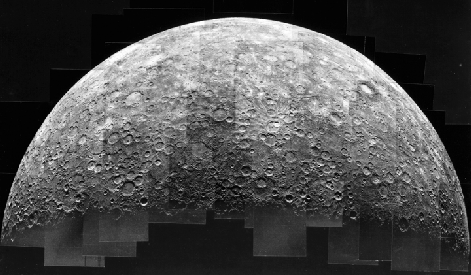Astronomy Picture of the Day
Discover the cosmos!
Each day a different image or photograph of our fascinating universe is
featured, along with a brief explanation written by a professional
astronomer.
September 12, 1996

Mercury: A Cratered Inferno
Credit:
Mariner 10,
NASA
Explanation:
Mercury's surface looks similar to our Moon's. Each is heavily
cratered and made of rock.
Mercury's diameter is about 4800 km, while the
Moon's is slightly less at about 3500 km (compared with about 12,700 km for the
Earth). But
Mercury is unique in many ways.
Mercury is the closest planet to the
Sun, orbiting at about 1/3 the radius of the
Earth's orbit. As
Mercury slowly rotates, its surface temperature varies from an unbearably cold -180 degrees
Celsius to an unbearably hot 400 degrees
Celsius. The place nearest the
Sun in
Mercury's orbit changes slightly each orbit - a fact used by
Albert Einstein to help verify the correctness of his then newly discovered theory of gravity:
General Relativity.
The above picture was taken by the only spacecraft ever to pass
Mercury:
Mariner 10 in 1974.
Tomorrow's picture: Southwest Mercury
<
Archive
| Index
| Search
| Calendar
| Glossary
| Education
| About APOD
>
Authors & editors:
Robert Nemiroff
(MTU) &
Jerry
Bonnell (USRA)
NASA Technical Rep.:
Jay Norris.
Specific rights apply.
A service of:
LHEA
at
NASA/
GSFC
&:
Michigan Tech. U.
